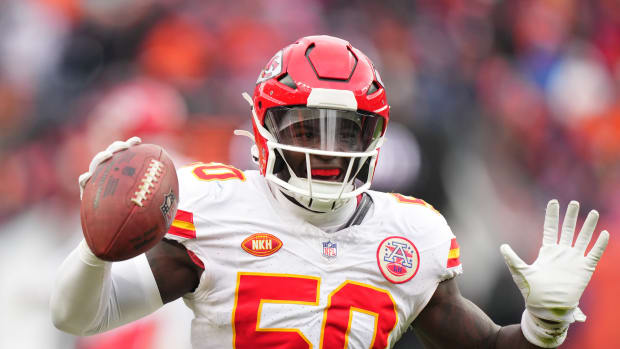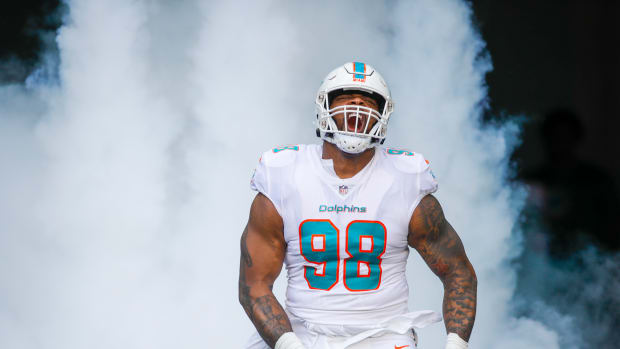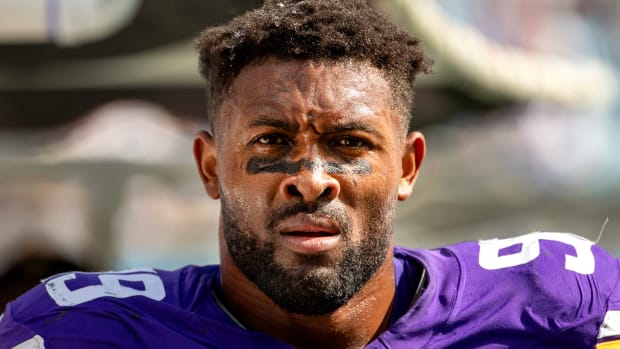Super Bowl 51 Film Notes
Patriots’ O vs. Falcons’ D
1. Overall, the film showed exactly what the live game showed: the Falcons’ defense got tired. The Falcons did not change anything schematically in the second half, they just did everything a beat slower. That included rushing the passer. After a noisy first half they had a few flashes but were mostly ineffective. With a clean pocket to work from, Tom Brady made several tremendous tight-window throws. He was flawless down the stretch.
2. Atlanta’s foundation was man-to-man, not their usual Cover 3. That had become the case more and more as the season wore on. Their man coverages often had a free defender (aka a “robber”) in the shallow middle of the field—a great tactic to negate New England’s crossing patterns.
3. The Falcons had an outstanding wrinkle out of their man-free robber coverage: if cornerback Robert Alford’s receiver (it was almost always Julian Edelman) ran a crossing pattern, Alford would pass him off to the robber. This meant Alford became the new robber. The first time Brady saw this, he failed to process it and nearly threw a near-interception to Alford. The next time Brady saw it, he again failed to process and did throw the interception (Alford’s pick-six). In the second half, Brady would see it again and wind up converting third-and-8 with a 15-yard scramble.
• COLLEGE COLUMN: Sizing Up the NFL Draft’s QB Market
4. Atlanta’s other wrinkle out of man coverage was having linebacker Deion Jones align over the center or guard and then drop back to double-team the closest inside receiver (usually Edelman). The Falcons did this a lot when the Patriots went to spread empty formations. You wonder if the Patriots were surprised by this; all season long, Jones in man coverage had taken the running back. With Jones doubling Edelman, safety Keanu Neal often took the running back (it was almost always James White). That left linebacker De’Vondre Campbell on tight end Martellus Bennett. The Falcons paid for this mismatch on the overtime drive when Campbell got flagged for pass interference near the goal line.
5. Robert Alford matched up with Julian Edelman on almost every snap. At times, the coverage concept gave Alford help inside, at other times it was pure one-on-one. Overall, Alford won the battle, capping his terrific postseason.
6. Left tackle Nate Solder could not block Dwight Freeney. The 36-year-old defensive end won with speed moves, power moves and spin moves. In the second half, the Patriots gave Solder help via chip-blocks. That, plus Atlanta’s fatiguing D-line, led to a quieter pass rush, changing the tenor of the game.
7. Danny Amendola had three enormous catches out of the slot against rookie corner Brian Poole in man coverage. The first was a 17-yard out-route to convert fourth-and-3 on New England’s first touchdown drive. The second was a 20-yard deep cross on the game-tying TD drive. The third was a 14-yard out-route in overtime. Without those plays (particularly the first two), the Patriots would not have won Super Bowl 51.
• MAILBAG: Good Mourning, Falcons
8. The Falcons blitzed two times all game (that’s not atypical for a defense facing Brady). On most passing downs, they featured stunts—a Dan Quinn staple. The stunts got home when the coverage was tight, but too often they developed too slowly. That’s the risk you run with stunts.
9. The biggest, and best, play of the game came against one of Atlanta’s two blitzes. It was third-and-10 on the final drive of regulation, New England backed up. Brady from a shrinking pocket threw an unbelievable anticipation pass to Chris Hogan on an out-route to beat a Cover 3 zone (a lightened zone since the blitz meant one less defender in coverage). A millisecond difference here, a centimeter there and that ball would have been incomplete.
10. Most remarkable of all: the Patriots came back from 25 down without any plays going for huge gains. Their longest play on the night was James White’s 28-yard catch late in the second quarter. They methodically carved up a Falcons defense that was extremely fast in the first half but grew increasingly slower.
Falcons’ O vs. Patriots’ D
1. First things first: Trey Flowers’s sack. The criticism of Matt Ryan is fair, though the tone has been too harsh. It wasn’t a choke job, just a poor quarterback play. Ryan looked to Mohamed Sanu on the crosser. Logan Ryan’s man coverage was tight, but given the circumstances, the quarterback needs to attempt the throw (which probably means taking the incompletion). That said, the biggest factor on the play wasn’t Ryan holding the ball (he didn’t hold it ridiculously long), it was Flowers beating Pro Bowl center Alex Mack. And keep in mind: Ryan can’t, and shouldn’t, anticipate Mack getting beat. The Patriots were not in a blitz look, so there was no reason for the QB to speed up his mental process.
2. On the play described above, Ryan’s initial read was to Julio Jones. The Patriots, as they did much of the game, doubled Jones. In this case, the double-team was in the form of a bracket coverage. Typically, a QB should come off this read immediately and look elsewhere. Ryan, however, lingered for a fraction of a second. And that’s understandable; two plays earlier, Ryan had targeted Jones versus another double-team and it resulted in the unbelievable 27-yard sideline catch. That may have been Ryan’s best throw on the season.
• VRENTAS: Edelman’s Catch, How’d That Happen?
3. As for Dont’a Hightower’s strip-sack: that was all on Devonta Freeman. He simply overlooked the most basic of blitz pickups. Mental gaffes happen. Yes, Kyle Shanahan’s third-and-1 play-call was aggressive: a five-step drop out of shotgun (which equates to seven-step timing). But the call actually worked; receiver Aldrick Robinson beat Malcolm Butler deep. Ryan just never got a chance to throw it. A bad result does not equal a bad play call. Shanahan couldn’t have known Freeman would blow the most basic of blitz pickups. When evaluating a play-caller, you must separate the results from the call.
4. Shanahan, by the way, was outstanding throughout the game, particularly in the first half. As he’s done all season, he diversified his formations and personnel packages and shrewdly built plays off of each other, making calls that set up later calls. The Patriots were on their heels.
5. What changed for the Patriots was their pass rush. It picked up down the stretch, which changed Atlanta’s timing ever so slightly and led to a handful of big plays (including Chris Long’s drawn hold on left tackle Jake Matthews)
6. It was a Belichickian performance in that the Patriots consistently changed up their defensive fronts and especially their coverages. They were particularly multiple out of man-to-man, putting different corners on different receivers throughout the game.
7. Even without the strip-sack, Dont’a Hightower was New England’s defensive MVP. He was absolutely sensational setting the edge after halftime.
• SUPER BOWL 51: The Greatest Comeback Ever
8. Setting the edge was important because the Falcons clearly felt their ground game could beat the Patriots to the perimeter. And, at times, it did. Toss-crack was a featured play (toss to the back, wide receivers crack down to block the edge). The best came on Atlanta’s first snap, when Devonta Freeman gained 37 yards.
9. On Freeman’s 39-yard dumpoff catch in the fourth quarter, linebacker Elandon Roberts did indeed blow his coverage—as many viewers at home suspected. It was man-to-man. Roberts had Freeman. When he saw a fake handoff to Freeman, Roberts incorrectly turned and ran with Mohamed Sanu’s “over” route. Costly mistake.
10. Alan Branch vs. Alex Mack was a good battle in the ground game. Mack won the first half; Branch won the second. Branch, who is now a free agent, was as good as any interior run defender in football down the stretch this season.
Question? Comment? Story idea? Let us know at talkback@themmqb.com




































